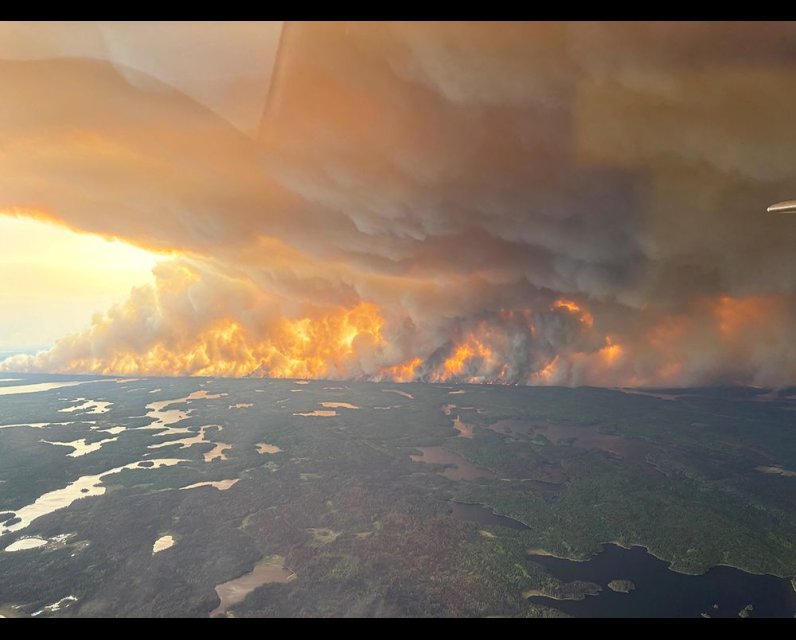Wildfires spark friendly disagreement as Trump administration pushes Canada to ‘lean into forest management’

This year’s Canadian wildfires and their impact American air quality have been a hot topic between the countries’ governments, with the Trump administration urging Canada to emphasize “forest management” as an antidote, the head of the U.S. Environmental Protection Agency (EPA) said Friday.
But the two nations don’t necessarily agree on the role of such measures, EPA chief Lee Zeldin suggested during a meeting of G7 environment and energy ministers in Toronto.
Climate scientists and data indicate that a warming planet has made forest fires wilder and bigger, something even the U.S. space agency NASA confirms . But Zeldin is an opponent of what he has called the “religion of climate change,” and proposed scrapping his agency’s ability to regulate fossil fuels, the foundation of U.S. efforts to combat climate change.
Facing pressure from politicians in states affected by drifting smoke, there has been “a lot of engagement” during the last three months with Environment Canada about the wildfires that ravaged huge tracts of forest here, said Zeldin.
“The impacts on the northern United States led to a lot of advocacy and questions coming from United States governors and congressional delegations and others,” he told a news conference during the G7 gathering.
“What Canada experienced, just like what California experienced last January highlights the need to lean into forest management.”
Zeldin praised Canadian officials for promptly answering his team’s questions about the fires, but suggested that there was a friendly clash about how to address the issue.
“Even though Canada might have a different approach to how to fight that particular wildfire that impacted them, and California might have a different approach than the Trump administration might prefer, that doesn’t mean we shouldn’t have maximum open dialogue as much as possible,” he said.
Zeldin said there were a lot of cross-border issues when he met Canadian Environment Minister Julie Dabrusin at this week’s G7 get-together, but “I just want to emphasize that (wildfires) was a topic I sought to raise at the first opportunity in our conversation.”
The interaction underscores a curious aspect of this week’s G7 meeting – the Trump cabinet officials’ rejection of climate change put the U.S. starkly at odds with the group’s other members.
This year’s fires actually became a political issue in the U.S., with a group of six Republican lawmakers from Wisconsin and Minnesota writing to Kirsten Hillman, Canada’s ambassador to Washington, to complain about their impact, and blame this country.
“Our communities shouldn’t suffer because of poor decisions made across the border,” Tom Tiffany, a Republican congressman from Wisconsin, said in a post on X in July.
Using management techniques like controlled burns, clearing away combustible debris from forest floors and creating fire breaks is a widely accepted means to lessen fire danger.
But Manitoba Premier Wab Kinew rejected the U.S. critiques at the time, noting that most of the fires in his province were started by lightning strikes in remote locations where preventive measures were all but impossible.
Asked about Zeldin’s comments Friday, Canadian Environment Minister Julie Dabrusin wouldn’t say how her department responded to the American outreach.
“When we’re talking about wildfires in Canada, my primary obligation and concern is about Canadians who are being impacted,” said Dabrusin. “Do I share an absolute commitment to slow down wildfires and protect communities? Absolutely.”
A leading academic expert was less diplomatic. The growing threat from wildfires is a complex one and research has proven that climate change – creating hotter, drier conditions – is the principle cause, said Lori Daniels, a forestry professor at the University of British Columbia.
“If the United States wants to contribute to a global solution, they need to reduce their greenhouse-gas emissions,” said Daniels. “Given that they are in the top-three of greenhouse-gas emitters, maybe the onus could go back to them for some of that responsibility.”
Another factor feeding the fire surge is, ironically, a decades-long history of efficient firefighting, she said. That has led to denser forests and growth of small trees that provide a sort of kindling to the flames that start by crawling along the forest floor. Meanwhile, the uniformity of vast oceans of evergreen trees makes them more susceptible to fire, disease and insects, said Daniels.
The kind of forest management that is “desperately needed” would require a timber industry shift toward harvesting smaller trees and for more broad-leaf species to be integrated into forests. But that would undermine a business model centred around selling the U.S. two-by-fours and similar products cut from big, old trees. Governments would probably have to offer subsidies and other incentives, Daniels said.
The further catch? Government subsidy generally prompts the U.S. to raise softwood-lumber tariffs, which have already gone up under President Donald Trump.
“Those rules to try to control our economy limit our options and, unfortunately, (Americans) had to pay the price this summer by breathing some smoke. They can’t have their cake and eat it too.”
Our website is the place for the latest breaking news, exclusive scoops, longreads and provocative commentary. Please bookmark nationalpost.com and sign up for our daily newsletter, Posted, here.



Comments
Be the first to comment